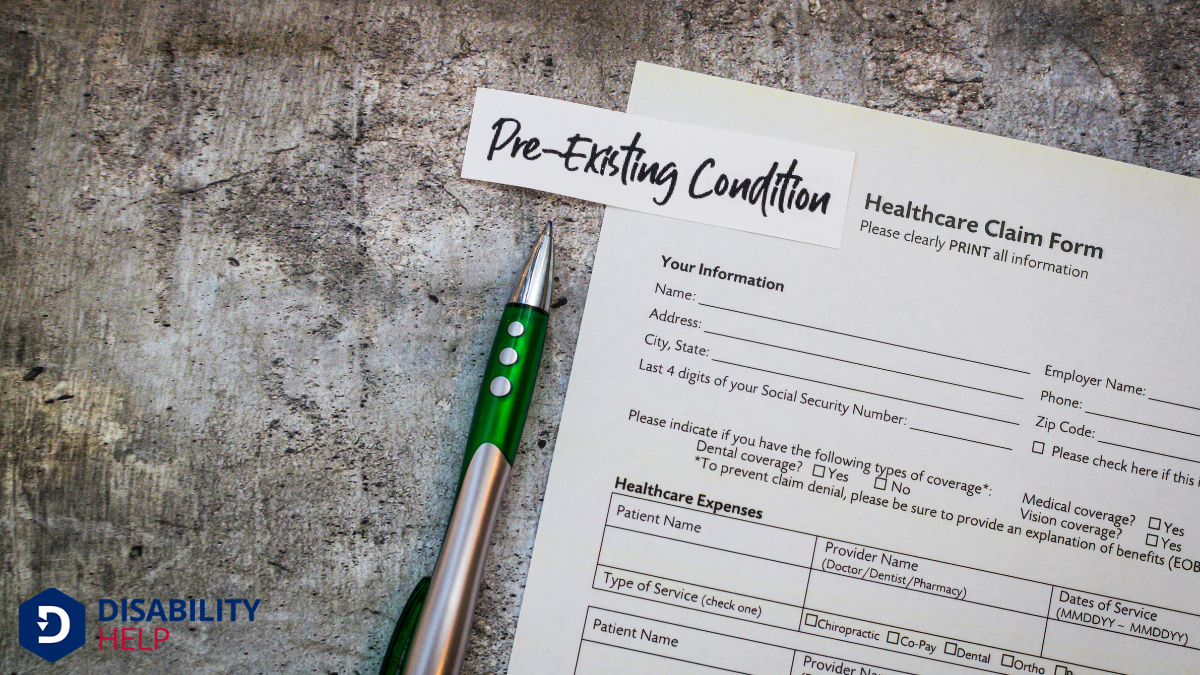Short-term disability plans typically exclude or limit coverage for pre-existing conditions, which are health issues diagnosed or treated before the policy start date. Waiting periods and specific plan terms often delay or restrict benefits related to these conditions. However, there are ways to secure coverage, like choosing the right plan or negotiating terms. Understanding how pre-existing conditions impact coverage is essential, as there are more insights to be explored.
Key Takeaways
- Coverage for pre-existing conditions varies widely among short-term disability plans and depends on specific policy terms.
- Pre-existing condition clauses often exclude conditions treated before the policy's start date.
- Some insurers may offer coverage after a waiting period for pre-existing conditions.
- State regulations can influence coverage options for pre-existing conditions.
- Negotiating plan terms might improve coverage possibilities for pre-existing conditions.
Understanding Short-Term Disability Insurance
Short-term disability insuranceInsurance that provides income replacement for a limited time when an employee is unable to work due... plays an essential role in providing financial protection when we're unable to work due to temporary medical conditions. It offers us a safety net by replacing a portion of our income, ensuring we can still meet financial obligations during recovery.
Understanding this coverage is vital for making informed decisions about our financial well-being.
Typically, short-term disability benefitsFinancial assistance provided to individuals who are unable to work due to a disability, such as Soc... kick in after a brief waiting period, often around one to two weeks, and can last from a few weeks to several months. The exact terms of coverage depend on the policy details we choose.
Definition of Pre-Existing Conditions

Pre-existing conditions are medical issues we've been diagnosed with or received treatment for before obtaining a new insurance policy. These might include chronic illnesses like diabetesA chronic condition where the body cannot produce or properly use insulin, leading to high blood sug... or heart disease, or even past surgeries.
When we seek new insurance, understanding what qualifies as a pre-existing condition is vital because it impacts our coverage options. Insurance companies assess these conditions to determine risk and coverage limits.
It's essential to review the specific definitions and timelines insurers use, as they can vary. Some might consider a condition pre-existing if you've had symptoms or treatment within a certain period before the policy begins.
Knowing these details helps us make informed decisions about our coverage needs and anticipate how our medical history might affect our insurance benefits.
Common Exclusions in Disability Plans
As we explore common exclusions in disability plans, we’ll focus on three key areas: pre-existing condition clauses, coverage waiting periods, and specific medical exclusions.
Understanding these elements helps us navigate the complexities of what mightn't be covered.
Let’s break down each of these so we’re better prepared when choosing a plan.
Pre-Existing Condition Clauses
While exploring disability insuranceA form of insurance that provides income to individuals who are unable to work due to a disability., it’s vital to understand how pre-existing condition clauses can impact our coverage.
These clauses often exclude conditions for which we've received treatment or advice before our policy's start date. Insurers use them to minimize risk, meaning we might face restrictions if we've had a recent diagnosis or ongoing medical issue.
It's important to review the policy details carefully, as each insurer defines "pre-existing" differently.
Coverage Waiting Periods
Steering through the world of disability insurance, we often encounter coverage waiting periods, a significant aspect to understand.
These periods refer to the time between the start of our disability and when benefits actually begin. It’s important to be aware that short-term disability plans typically include a waiting period, often ranging from a few days to a couple of weeks. This means we won't receive benefits immediately after becoming disabled.
Understanding the specifics of our plan is essential since different insurers have varying requirements. By knowing these details upfront, we can make informed decisions and avoid surprises at an already difficult time.
Let's make sure we review our policy documents carefully, focusing on the waiting period details, so we're prepared if we ever need to rely on these benefits.
Specific Medical Exclusions
Beyond the waiting periods, it’s important to understand what our short-term disability plan may not cover. Some common medical exclusions can surprise us if we're not aware.
For instance, many plans exclude coverage for disabilities resulting from self-inflicted injuries or those related to illegal activities. If we're injured while committing a crime, our plan likely won't offer benefits.
Pregnancy is another area to watch; while some plans might cover complications, standard pregnancies are typically excluded.
Mental health conditions can also be tricky, as certain plans exclude or limit coverage for these issues.
It’s vital to review our specific policy details, as exclusions vary widely. By understanding these exclusions, we can better prepare for situations that might leave us without financial support when we need it most.
The Role of Waiting Periods
Waiting periods play an important role in short-term disability plans by determining when benefits begin after a claim is filed. Typically, these periods range from a few days to a couple of weeks.
We might wonder why they exist. Essentially, they help insurance companies manage costs and prevent claims for brief illnesses that resolve quickly. For us, understanding this timeframe is vital as it affects when we receive financial support.
If we've a pre-existing condition, the waiting period might be longer or the condition mightn't be covered immediately.
Reviewing our policy details guarantees we’re aware of any waiting periods applicable to our situations. By knowing these details, we can better plan for any gaps before benefits start, guaranteeing we’re prepared financially.
State-Specific Regulations and Variations

While managing short-term disability plans, it’s important to understand that state-specific regulations can greatly impact coverage and eligibility.
We need to be aware of these variations to guarantee we're making informed decisions. Different states may have unique requirements that can affect whether pre-existing conditions are covered.
Let's explore some key points:
- State Mandates: Some states have mandates requiring coverage for certain conditions, influencing plan options.
- Coverage Limits: States may impose limits on the amount or duration of coverage, impacting benefits.
- Waiting Periods: State regulations might dictate the length of waiting periods for pre-existing conditions.
- Plan Types: Certain states may offer specific plan types not available elsewhere.
Strategies for Securing Coverage With Pre-Existing Conditions
When we're trying to secure short-term disability coverage with pre-existing conditions, it's essential to understand policy limitations and how they might affect us.
We should explore alternative options that could offer more favorable terms, and don't hesitate to negotiate plan terms to better suit our needs.
Understanding Policy Limitations
Maneuvering the complexities of securing coverage with pre-existing conditions under short-term disability plans requires a keen understanding of policy limitations.
We must familiarize ourselves with the fine print to make informed decisions. Short-term disability plans often have specific restrictions that can impact coverage for pre-existing conditions.
Key elements to take into account include:
- Exclusion Periods: These are timeframes during which coverage for pre-existing conditions isn't available.
- Definition of Pre-Existing Conditions: Policies may vary in what they identify as a pre-existing condition.
- Coverage Limits: Some plans cap the amount payable for conditions deemed pre-existing.
- Waiting Periods: Understanding the length of time before coverage begins is essential.
Let’s carefully review all documents and ask questions, ensuring we’re fully informed of potential limitations.
Exploring Alternative Options
Although managing short-term disability plans with pre-existing conditions can be challenging, there are alternative options we can explore to secure coverage.
First, we might look into employer-sponsored plans, which often offer more lenient terms regarding pre-existing conditions. Employers sometimes provide coverage options not available in individual policies.
Additionally, we can consider supplemental insurance plans that specifically cover gaps left by primary insurance. These plans can be more flexible and tailored to our needs.
Another option is to join professional or trade associations that offer group disability insurance. These can provide more favorable terms due to collective bargaining power.
Finally, let's not overlook government programs such as MedicaidA U.S. government program that provides health coverage to eligible low-income individuals, includin... or state-specific options that might offer some level of support.
Negotiating Plan Terms
Securing coverage with pre-existing conditions often requires careful negotiation of plan terms, and understanding our leverage points can make all the difference.
When we approach insurers, having a strategy helps us secure better terms. Here are some steps to deliberate:
- Research Insurers: Identify companies that are more flexible with pre-existing conditions.
- Gather Documentation: Provide detailed medical records to demonstrate stability and management of the condition.
- Highlight Employment Stability: Emphasize a strong employment record, which insurers may view positively.
- Request Exclusions: Propose specific exclusions for certain conditions to potentially lower premiums.
Evaluating and Comparing Policy Options
How do we navigate the maze of short-term disability plans, especially when pre-existing conditions are a factor?
First, let's identify our specific needs and examine the eligibility criteria and exclusions of each plan. We should compare waiting periods, coverage duration, and any limitations related to pre-existing conditions. It's essential to look for policies that offer the most thorough coverage, considering our medical history.
Next, we can evaluate the cost-effectiveness of the plans by examining premiums and potential out-of-pocket expenses.
Reading policy reviews and seeking opinions from trusted sources can provide additional insights.
Finally, engaging with an insurance advisor might help us understand the nuances of each option. By carefully comparing these elements, we can choose a policy that best suits our circumstances.
Conclusion
In summary, when it comes to short-term disability plans, maneuvering through pre-existing conditions can be challenging. However, by understanding the terms and exclusions, we can make informed decisions. It's essential to reflect on the role of waiting periods and be aware of state-specific regulations that might affect coverage. By carefully evaluating and comparing policy options, we can find strategies to secure the coverage we need. Let's stay proactive and guarantee we're prepared for any unexpected circumstances.






